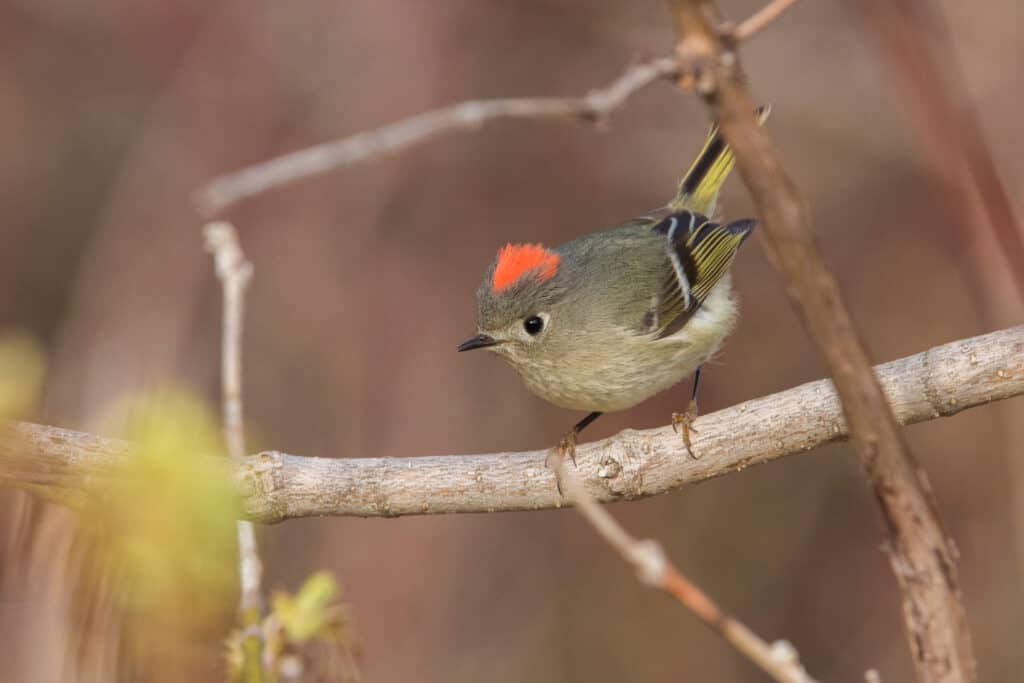Ruby-Crowned Kinglet
Corthylio Calendula
Advertisement
Ruby-Crowned Kinglet Scientific Classification
- Kingdom
- Animalia
- Phylum
- Chordata
- Class
- Aves
- Order
- Passeriformes
- Family
- Regulidae
- Genus
- Corthylio
- Scientific Name
- Corthylio Calendula
Read our Complete Guide to Classification of Animals.
Ruby-Crowned Kinglet Conservation Status
Ruby-Crowned Kinglet Facts
- Name Of Young
- Hatchlings
- Group Behavior
- Solitary/Pairs
- Estimated Population Size
- 100 million
- Wingspan
- 6.3 - 7.1 in
- Incubation Period
- 12-14 days
- Age Of Fledgling
- 16-18 days
- Average Spawn Size
- 5-12 eggs
- Habitat
- Tall, dense conifer forests
- Predators
- Owls, Hawks, Merlins, Grackles, Jays, Squirrels
- Diet
- Omnivore
- Nesting Location
- Near the tree trunk or suspended from small branches
- Migratory
- 1
Ruby-Crowned Kinglet Physical Characteristics
- Color
- Grey
- Red
- Black
- White
- Skin Type
- Feathers
- Lifespan
- Up to 5 years
- Weight
- 0.24 oz
- Length
- 3.5 - 4.3 inches
- Age of Sexual Maturity
- 1 year
- Venomous
- No
- Aggression
- Low
View all of the Ruby-Crowned Kinglet images!
The Ruby-Crowned Kinglet is one of the smallest songbirds found in North America. The males have a red patch on the top of their heads. However, this is rarely displayed and is usually hidden.
They are known for their apparent nervousness, in that they constantly flutter their wings as they dart around bushes and trees looking for food. They lay up to 12 eggs at a time, which is the most of any North American bird of its size.
4 Amazing Ruby-Crowned Kinglet Facts
- The Ruby-Crowned Kinglet characteristically flips its wings as they dart through foliage and bushes. This seemingly nervous trait is the easiest way to spot them.
- Ruby-Crowned Kinglets lay the largest number of eggs of any small bird its size in North America, up to 12 at once. The eggs can weigh as much as the female.
- Studies have shown that the Ruby-Crowned Kinglets only burn about 10 calories daily, despite their nervous habits.
- The Ruby-Crowned Kinglet is a songbird whose vocalizations are unusually loud and complex for a bird of its size. Their song often has three parts and can vary depending on the individual bird. The females typically only sing the first two parts, with the males singing all three.
Where to Find Ruby-Crowned Kinglets
The best place to find Ruby-Crowned Kinglets is in the trees and bushes around the forests and fields in North America. You may notice them darting around the bushes very quickly, making them hard to follow.
They constantly flick their wings, which is the best tell that you have found one. During the winter, they are found across most of North America, but in the summer, they are limited to Canada or the higher elevations of the western Rocky Mountains.
Ruby-Crowned Kinglets Nests
The Ruby-Crowned Kinglet make their nests high up in trees, sometimes as high as 100 feet. Their breeding area is Canada and the Western Rocky Mountains. Since these areas are remote, it is often hard to find their nesting location. The females will choose a remote and protected location, usually underneath overhead foliage.
It takes the females approximately five days to build the nest. They will use materials near the nest, such as moss, feathers, grass, and spiderwebs. The globe-shaped nest is four inches wide and five to six inches deep.
Inside, it is about three inches wide and two inches deep. The inside is made from softer material and is flexible, allowing the nest to expand as the young grow.
Ruby-Crowned Kinglet Scientific name
The Ruby-Crowned Kinglet has the scientific name of Corthylio calendula. Its class is Aves, and it belongs to the Regulidae family. The Genus name Corthylio comes from the Ancient Greek word Korthilos, a small wren-like bird mentioned by the Greek lexicographer Hesychius of Alexandria.
The three subspecies are:
- Corthylio Calendula Grinnell – Found in western North America, breeds in Alaska, southwest Canada, and the northwest US. Spends the winter in the western US.
- Corthylio Calendula calendula – Found in eastern North America, breeds in central and east Canada, southwest, central, and the eastern US. Spends winter in north Central America.
- Corthylio Calendula obscurus – Found on Guadalupe island off the northwest coast of Mexico.
Ruby-Crowned Kinglet Size, Appearance, and Behavior
The Ruby-Crowned Kinglet is a small bird, ranging from 3.5 to 4.3 inches long. It has a wingspan of 6.3 to 7.1 inches and weighs 0.2 to 0.4 ounces. Its upper body is gray-green in color, with the lower body an olive-buff color.
Overall, their body is small, with a comparatively large head, virtually no neck, and a thin tail. Their bills are very small and thin. They have a noticeable white ring around their eyes and white and black bars on their wings.
The males have a “ruby crown” on their heads, hence their name. This crown is rarely visible.

The ruby crown is clearly visible in this photo of a male Ruby-Crowned Kinglet.
©Mircea Costina/Shutterstock.com
Ruby-Crowned Kinglet Migration Pattern and Timing
Migration of the Ruby-Crowned Kinglet occurs in the fall and early winter. They will fly to the southern areas of North America and into Mexico and Central America.
In the summer months, they will travel to Canada and the Rocky Mountains of the western US to have their young.
Ruby-Crowned Kinglet Diet
What Does the Ruby-crowned Kinglet Eat?
They mainly eat spiders and insects such as ants, beetles, and wasps. They will also occasionally eat fruit seeds, such as dogwood and poison-oak berries. These birds will forage through the trees and bushes looking for insects on the branches and leaves.
Ruby-Crowned Kinglet Predators, Threats, and Conservation Status
What Eats Ruby-Crowned Kinglets?
Typical predators include cats, bats, foxes, snakes, eagles, hawks, and owls. Since these small birds are very fast, it is hard for these predators to target them away from their nests.
For example, a cat may lay and wait to ambush one near the ground, or an owl may target them around their nest. The Kinglet is a fearless defender of their nest, sometimes pretending to have a broken wing to draw predators away from the nest.
They will also mob a predator approaching and continuously diving at them.
Ruby-Crowned Kinglets in North America are currently of low conservation concern. Their breeding is in mainly remote areas of Canada, and their wide use of habitats in the winter allows them to tolerate human disturbances to the landscape.
The subspecies obscurus from Guadalupe Island, however, is considered endangered and may already be extinct.
Reproduction, Young, and Molting
Ruby-Crowned Kinglets lay the most eggs of any small bird its size in North America, up to 12 at once. They will lay the eggs in late spring and early summer. The incubation period is 12-14 days, and the young leave the nest about 16-18 days later.
The parents will stay together for about two months and separate once the young begin to fledge and leave the nest.
Population
Ruby-Crowned Kinglets are common and of no conservation concern. There have been some sharp increases and decreases in population, but their numbers overall have been stable and estimated at 100 million.
They seem to tolerate human disturbances fairly well, and their wide use of habitats in remote areas helps maintain their numbers.
Similar Animals
View all 114 animals that start with RRuby-Crowned Kinglet FAQs (Frequently Asked Questions)
Does the Ruby-Crowned Kinglet migrate?
Yes, they migrate to the Northern areas of North America in the summer to breed and to the southern areas during the winter.
How many eggs does the Ruby-Crowned Kinglet lay?
They lay the most of any small bird in North America, up to 12.
How fast does Ruby-Crowed Kinglets fly?
They are small and very fast in short distances – often too fast for the human eye to keep up with.
What is the Ruby-Crowned Kinglet's Wingspan?
Their wingspan is 6.3 to 7.1 inches across.
When do Ruby-Crowned Kinglets leave the nest?
Usually, they leave the nest around 16 days after hatching.
Thank you for reading! Have some feedback for us? Contact the AZ Animals editorial team.


















